History
Like the MB during the 1920s and early thirties of the twentieth century the Martin B-10 series set standard for land bombers. The design was the first successful military application of the new airframe technology and had a streamlined monocoque fuselage, propellers with variable pitch adjustment, thick metal wings with lift enhancing flaps, integral fuel tanks and a retractable landing gear.
The B-10 was designed in response to an Air Corps bomber specification from late 1929. Besides Martin also Fokker, Keystone, Douglas, Ford and Boeing, presented a design or prototype.
The first Martin's proposal for a conventional biplane was rejected by the USAAC Equipment Division with a range of suggestions for improvement. In February 1932 Martin built for his own account, a new model of the 123 with two Wright R-1820 Cyclone engines. It had a speed of 317 km/h (197 mph), which was faster than competing aircraft. With the designation XB-907, the prototype was tested on Wright Field.
Several problems occurred, such as vibrations from the engines, instability during flight and furthermore the landing speed was too high; this turned out to be 146 km/hr (91 mph). So it was sent back to the Martin factory with a list of suggestions for improvement.
Partly due to the impact of the stock market crash of 1929 the design had now become vital for the survival of the Martin factory. Martin went to work on the results of the tests to improves the Martin 123.
The Martin 123 received extended wings, integrated with the hull and more powerful Cyclone engines mounted in new streamlined NACA caps.
The landing gear was changed and a new nose turret was developed.
In October 1932, the XB-907A was ready. The device was not only faster than the competing Boeing XB-9 and Douglas XB-7, but was also just as fast as the latest fighter aircraft of the USAAC from that time.
In January 1933 an order for 48 aircraft was scooped.
The XB-907A, was now referred to as XB-10 and 13 similar YB-10's had to be delivered plus one YB-10A for testing Wright engines with turbo compression had to be delivered.
Seven YB-12s were to be built for testing with Pratt & Whitney R-1690 Hornet engines, followed by 25 ordinary B-12A with the same engines, but equipped with extra fuel tanks and floating chambers and finally an experimental XB-14 with new Pratt & Whitney R-1830 Twin Wasps.
The YB-10 and YB-12 were delivered in early 1934 and were soon deployed for an unusual mission. All airmail contracts were cancelled due to corruption, and airmail now had to be taken care of by the USAAC.
The large, fast aircraft proved to be a godsend because of their reliability and security.
After these successes, Martin was actually expecting more large orders. Despite discussions Martin received contracts for 103 aircraft, in the final B-10B version with Wright R-1820/33 engines, spread over fiscal years 1934 and 1935.
The B-10's did service in every bombardment group of the Air Corps. In 1935 some were used for tests of Norden precision bomb sights.
The success stimulated the development of larger, long-range bombers which would replace the B-10, especially the Boeing B-17 Flying Fortress.
Already in 1936the USAAC lost interest in B-10 bomber. A few were tested as attack and observation plane, referred to as A-15 and D-45.
Despite a number of disputes with Martin about the design and occurring construction defects in the B-10 series, in the spring of 1940, yet 119 of the 151 aircraft were still in service. Most were used as target tugs, and for training as a B-10M and B-12AM, though seventeen aircraft were still in operational service in the Philippines.
In 1936, the Martin 139 was released for export and 189 aircraft were eventually sold abroad.
The Soviets were in the summer of 1936, the first with the purchase of a single copy and blueprints, soon followed by the Netherlands East Indies, China, Siam, Argentina and Turkey with various orders.
The Dutch were the best customers with the purchase of a total of 120 aircraft in four different versions for the defence of the Dutch East Indies.
Foreign orders for Model 139 Martin kept the factory busy until 1939. One of the Argentine Martins is the only survivor of the type and was completely restored in the pre-war Air Corps colours and can be seen in the Air Force Museum at Wright-Patterson Air Force Base.
| Dimensions: | |||
| Length: | 13,6 m | Wing span: | 21,5 m |
| Height: | 4,7 m | Wing area: | 63 m2 |
| Weights: | |||
| Empty weight: | 4391 kg | Max. start weight: | 6680 kg |
| Performance: | |||
| Cruising speed: | 310 km/hr | Max. speed: | 343 km/hr |
| Climbing speed: | 420 m/min | ||
| Service Ceiling: | 7380 m | Range: | 1996 km |
| Miscellaneous: | |||
| Engine type: | Two Wright Cyclone R-1820-F53 rated 750 hp | ||
| Crew: | Three men | ||
| Armament: | Three 7.62 mm machine guns; 1000 kg bombs | ||
| Dimensions: | |||
| Length: | 13,6 m | Wing span: | 51,5 m |
| Height: | 4,7 m | Wing area: | 63 m2 |
| Weights: | |||
| Empty weight: | 4391 kg | Max. start weight: | 6680 kg |
| Performance: | |||
| Cruising speed: | 310 km/hr | Max. speed: | 343 km/hr |
| Climbing speed: | - m/min | ||
| Service Ceiling: | 7380 m | Range: | 1996 km |
| Miscellaneous: | |||
| Engine type: | Two Wright Cyclone R-1820-G3 rated 840 hp | ||
| Crew: | Three men | ||
| Armament: | Three 7.62 mm machine gun; 1000 kg bombs | ||
| Dimensions: | |||
| Length: | 13,6 m | Wing span: | 51,5 m |
| Height: | 4,7 m | Wing area: | 63 m2 |
| Weights: | |||
| Weight (empty) | - kg | Weight (maximum) | - kg |
| Performance: | |||
| Cruising speed: | 310 km/hr | Max. speed: | > 343 km/hr |
| Climbing speed: | - m/min | ||
| Service Ceiling: | 7380 m | Range: | 1996 km |
| Miscellaneous: | |||
| Engine type: | Two Wright Cyclone R-1820G-102 rated 900 hp each | ||
| Crew: | Three men | ||
| Armament: | Three 7.62 mm machine gun; 1000 kg bombs | ||
In the mid thirties of the twentieth century several ideas were circulating about the defence and the rather young air force. One of these ideas was that an attack with bombers was the best way to defend.
The staff of the NEIAF supported this idea and asked several aircraft factories for an offer.
Fokker offered the Fokker T-V, which was still in development at that time. The American Martin company offered model 139, a version of the all metal Martin B-10. The B-10 was faster than the fighters in operational use at that time.
Finally the Martin 139 was selected and a series of 13 examples was ordered under the designation WH-1 as a replacement of the old Fokker C.V. [WH means Wright-Holland]
The planning foresaw the delivery of 39 aircraft, to be built under license in the Netherlands. Due to shortage of building capabilities it was decided to have the aircraft being built by the Martin aircraft factory. March 1937 a second series of 26 aircraft under the designation WH-2 was ordered.
The first WH-1, registered M-501, c/n 656, was handed over to the NEIAF on September 2, 1936. M-501 and M-502 arrived in December in the Dutch East Indies. M-502 made its first flight in January 1937 from air base Andir.
The second series was improved in several ways: more powerful Wright Cyclone G-3 engines rated 875 hp each., the Hamilton Standard–propeller with two positions was replaced with a Curtiss Electric ‘constant speed’ propeller. Furthermore the cowling was improved and more streamlined, a NSF VR-34B radio and also an auto-pilot was added.
The maximum speed was about 40 km/hr higher, the range was enlarged with about 10 % and the bomb load was about 20 % larger.
The first WH-2, serial M-514, construction nr. 717 was handed over in December 1937. All WH-2's were delivered in October 1938, so three divisions each with thirteen bombers (two spare, two in maintenance and nine operational) were operational.
The Martin 139 was developed to the Martin 166. This model had one single canopy, the cross section of the fuselage was enlarged, so more bombs could carried. The wings were slightly oblique backwards and the engines were replaced with the more powerful Wright Cyclone GR-1820-G5 rated 1000 hp each. For commercial reasons this model was called Glenn Martin 139 WH-3.
By the end of December 1937 a third contract for the delivery of 39 WH-3 was signed. The acceptance of the first WH-3, registered M-540, construction nr. 775, was may 1938.
November the same year a fourth contract was singed for the delivery of 40 Wh-3A’s. This type was identical to the WH-3, except that it was equipped with two Wright Cyclone R1820-G102 engines rated 1200 pk each.
The first WH-3A, serial M-579, construction nr. 837 was handed over in December 1938. April 1939 the third and last bomber division, VlG-III was operational at air base Tjililitan.
By the end of 1939 seven Martins were lost, 2 WH-1, 2 WH-2 and 3 WH-3’s.
When the Japanese attacked the Dutch East Indies the following units were operational:
| Andir: | 1-VlG-I and 2-VlG-I 9 Wh3/Wh-3A’s each plus 2 spare aircraft |
| Singorasi | 1-VlG II with 3 Wh2’s; 9 Wh-3/Wh-3A’s plus two spare aircraft |
| Tjililitan | 1-VlG II and 3-VlG III each 9 Wh3/Wh-3A’s plus 2 spare aircraft |
| Kalidjati | 7e division with 1 HW-1, 2 Wh-3 and 6 Wh-3A |
| WH-1-patrouille with 3 WH-1 plus one spare aircraft |
At the end of November 1941 so still operational:
- three examples of the WH-1 plus one reserve;
- Thirteen examples WH-2 plus 2 reserve;
- Thirty-five examples of the WH-3 / WH-3A plus 5 reserve.
- Not operationally deployable by maintenance or used for instruction, were 4 examples WH-1; six WH-2 and two WH-3 and three WH-3A.
DUTCH AIR FORCE IN BURMA - 1942; Kallang Airfield, Singapore 1941
So at the end of November 1941 operational were 3 WH-1's plus 1 spare; 13 WH-2's plus 2 spare; 35 WH-3/WH-3A plus 5 spare. Further, because of maintenance or training 4 WH-1s ; 6 WH-2s and 2 WH-3s and 3 WH-3As were not in operational use.
The first actions with the Martins were in the Borneo area. The Japanese were eager to conquer the oil fields. Soon the day light attacks were very hazardous. Alas the crews were hardly trained in night attacks.
During the three months of war many aircraft were lost in action.
(Via P. Guit) B.Guit flew with pilot officer Yland on Martin M-611. This aircraft was shot down on January 24, 1942 during the landing on Samarinda II together with two other aircraft. They came from Singosari (Singorasi as mentioned is not correct spelled). On January 25, 1942 they were evacuated in a Lodestar with a total of 30 men to Java , because not enough aircraft were available at Samarinda II.
By the end of February one succeeded to fly with the only Martin, M-585, left to Broome, Australia. The Martin was handed over to the USAF, which used it registered 42-68358.
The other aircraft probably eighteen examples were captured by the Japanese. Fifteen aircraft could be repaired to airworthy condition and several were handed over to Thailand. Thailand had bought six Martin 139’s in 1937. After the war about five Martins were left, which were in use until 1949.

[Enclosed photo from BeeldBank NIMH. Click on photo for ordering information]
The WH-3A’s were originally registered by the Martin factory M-579 till M-620. Because the serials in the M-600 range were not correct, these numbers were changed in August 1940 in M5100 till M5120.
An explanation of the registration system used: The NEIAF used a system in which the letter was a code for the aircraft factory and the first number referred to the purpose of the aircraft.
So M meant Martin and "5" meant bomber. The other numbers were in fact the aircraft number.
The serials were applied in white on the sides of the fuselage and the numbers were applied, in black on the front of the wing.
Glenn Martin 139 WH-1
| Serial
Serial
| Constr. nr.
Constr. nr.
| Date in service
Date in service
| Date out of service
Date out of service
| Notes
notes
|
|---|---|---|---|---|
| M-501 | 664 | 02-09-1936 | 09-03-1942 | Captured by the Japanese at Andir. |
| M-502 | 665 | 09-03-1942 | Captured by the Japanese at Andir. | |
| M-503 | 666 | |||
| M-504 | 667 | 09-03-1942 | Captured by the Japanese at Andir. | |
| M-505 | 668 | |||
| M-506 | 669 | |||
| M-507 | 670 | 09-03-1942 | Captured by the Japanese at Andir. | |
| M-508 | 671 | 09-03-1942 | Captured by the Japanese at Andir. | |
| M-509 | 672 | 09-03-1942 | Captured by the Japanese at Andir. | |
| M-510 | 673 | 25-01-1942 | Emergency landing in sea near Biliton | |
| M-511 | 674 | 09-03-1942 | Captured by the Japanese at Andir. | |
| M-512 | 675 | |||
| M-513 | 676 | 09-03-1942 | Captured by the Japanese at Andir. |
Glenn Martin 139 WH-2
| Serial
Serial
| Constr. nr.
Constr. nr.
| Date in service
Date in service
| Date out of service
Date out of service
| Notes
notes
|
|---|---|---|---|---|
| M-514 | 717 | |||
| M-515 | 727 | |||
| M-516 | 728 | 21-01-1942 | Destroyed during Japanese bombardment. | |
| M-517 | 729 | |||
| M-518 | 730 | |||
| M-519 | 731 | |||
| M-520 | 732 | 05-03-1942 | Damaged due to air attack Andir; used for spare parts. | |
| M-521 | 733 | 05-03-1942 | Damaged due to air attack Andir; used for spare parts. | |
| M-522 | 734 | |||
| M-523 | 735 | 09-03-1942 | Captured by the Japanese at Andir.. | |
| M-524 | 736 | 24-02-1942 | Written off after emergency landing because of engine failure. | |
| M-525 | 737 | |||
| M-526 | 738 | |||
| M-527 | 739 | |||
| M-528 | 740 | |||
| M-529 | 741 | |||
| M-530 | 742 | |||
| M-531 | 743 | 16-02-1942 | Emergency landing (in swamps) after being shot at by FLAK. Located in 1985 and parts of wing and other parts were preserved and sent to Militaire Luchtvaart Museum Soesterberg. | |
| M-532 | 744 | |||
| M-533 | 745 | |||
| M-534 | 746 | |||
| M-535 | 747 | |||
| M-536 | 748 | |||
| M-537 | 749 | 09-02-1942 | Shot down near Tjililitan | |
| M-538 | 750 | 09-02-1942 | Shot down near Tjililitan | |
| M-539 | 751 |
Glenn Martin 166 WH-3 and Wh-3A
| Serial
Serial
| 2nd Serial
2nd Serial
| Constr. nr.
Constr. nr.
| Date in service
Date in service
| Date out of service
Date out of service
| Notes
notes
|
|---|---|---|---|---|---|
| Serial | 2nd Serial | Constr. nr. | Date in service | Date out of service | Notes |
| Glennn-Martin WH-3 | |||||
| M-540 | 775 | 20-02-1942 | Destroyed due to Japanese attack of Kalidjati | ||
| M-541 | 776 | ||||
| M-542 | 777 | 09-03-1942 | Partly destroyed by ML-KNIL; captured by Japanese | ||
| M-543 | 778 | ||||
| M-544 | 779 | 20-02-1942 | Destroyed due to Japanese attack of Kalidjati | ||
| M-545 | 780 | 24-02-1942 | Destroyed during Japanese bombardment of Andir | ||
| M-546 | 781 | 20-02-1942 | Destroyed due to Japanese attack of Kalidjati | ||
| M-547 | 782 | 10-01-1942 | Written of after emergency landing | ||
| M-548 | 783 | ||||
| M-549 | 784 | 09-03-1942 | Partly destroyed by ML-KNIL; captured by Japanese | ||
| M-550 | 785 | ||||
| M-551 | 786 | 28-12-1941 | Shot down near Miri | ||
| M-552 | 787 | 12-01-1942 | Written off after nightly emergency landing | ||
| M-553 | 788 | ||||
| M-554 | 789 | 05-02-1942 | Crashing during take off from Pameumpeuk | ||
| M-555 | 790 | 23-12-1941 | Crashed | ||
| M-556 | 791 | 15-02-1942 | Captured by Japanese, after conquering of Singapore. | ||
| M-557 | 792 | ||||
| M-558 | 793 | 27-01-1942 | Destroyed during Japanese air attack of Oelin | ||
| M-559 | 794 | 24-12-1941 | Burned during bombardment | ||
| M-560 | 796 | 20-02-1942 | Destroyed due to Japanese attack of Kalidjati | ||
| M-561 | 797 | ||||
| M-562 | 798 | ||||
| M-563 | 799 | ||||
| M-564 | 800 | 27-01-1942 | Destroyed near Japanese air attack of Oelin | ||
| M-565 | 801 | ||||
| M-566 | 802 | ||||
| M-567 | 803 | ||||
| M-568 | 804 | 03-03-1942 | Shot to fire | ||
| M-569 | 805 | ||||
| M-570 | 806 | ||||
| M-571 | 807 | 18-12-1941 | Shot down near Miri | ||
| M-572 | 808 | 19-01-1942 | Emergency landing Zuid-Malakka after being attacked | ||
| M-573 | 809 | ||||
| M-574 | 810 | ||||
| M-575 | 811 | ||||
| M-576 | 812 | 15-02-1942 | Captured by Japanese, after conquering of Singapore.(was under repair) | ||
| M-577 | 813 | ||||
| M-578 | 814 | 16-02-1942 | Shot down near Palembang | ||
| Glenn-Martin WH-3A | |||||
| M-579 | 837 | 25-01-1942 | Destroyed during Japanese attack of Samarinda II | ||
| M-580 | 838 | 20-02-1942 | Destroyed during Japanese attack of Kalidjati | ||
| M-581 | 839 | 13-01-1942 | Shot down over Tarakan | ||
| M-582 | 840 | ||||
| M-583 | 841 | ||||
| M-584 | 842 | ||||
| M-585 | 843 | 08-03-1942 | Escaped to Australia; handed over to USAAF | ||
| M-586 | 844 | 01-01-1942 | Shot down near Penang | ||
| M-587 | 845 | ||||
| M-588 | 846 | 20-01-1942 | Destroyed by own personnel at Manggar | ||
| M-589 | 847 | ||||
| M-590 | 848 | ||||
| M-591 | 849 | ||||
| M-592 | 850 | 05-03-1942 | Shot down near Kalidjati | ||
| M-593 | 851 | ||||
| M-594 | 852 | ||||
| M-595 | 853 | ||||
| M-596 | 854 | ||||
| M-597 | 855 | 01-01-1942 | Shot down near Penang | ||
| M-598 | 856 | 09-03-1942 | Partly destroyed at Tasikmajala by own personnel. Captured by the Japanese | ||
| M-599 | 857 | 26-02-1942 | Shot down near Banka | ||
| M-5100 | M-600 | 858 | |||
| M-5101 | M-601 | 859 | |||
| M-5102 | M-602 | 860 | 09-03-1942 | Partly destroyed at Tasikmajala by own personnel. Captured by the Japanese | |
| M-5103 | M-603 | 861 | 13-01-1942 | Shot down over Tarakan | |
| M-5104 | 862 | ||||
| M-5105 | 863 | 09-03-1942 | Captured by the Japanese at Andir. Was under repair. | ||
| M-5106 | 864 | ||||
| M-5107 | 865 | ||||
| M-5108 | 866 | 03-03-1942 | Shot down over Kalidjati | ||
| M-5109 | 867 | ||||
| M-5110 | 868 | 24-01-1942 | Shot to fire during landing at Samarinda II-West | ||
| M-5111 | M-611 | 869 | 24-01-1942 | Shot to fire during landing at Samarinda II-West | |
| M-5112 | M-612 | 870 | |||
| M-5113 | M-613 | 871 | |||
| M-5114 | M-614 | 872 | 01-03-1942 | Captured by the Japanese at Kalidjati | |
| M-5115 | M-615 | 873 | 28-12-1941 | Shot down near Miri | |
| M-5116 | M-616 | 874 | |||
| M-5117 | M-617 | 875 | |||
| M-5118 | M-618 | 878 | |||
| M-5119 | M-619 | 1094 | |||
| M-5120 | M-620 | 1095 | 12-01-1942 | Emergency landing Barisan mountains | |
1/72nd Scale
Kits
- William Brothers
- Kit 72-210: a kit of a Martin B.10B
Modelling add-on
- Falcon
- VAX30: Canopies of US Aircraft in foreign Service (T6, Baltimore, Maryland, Hudson, Ventura, B10, Vengeance)
- Aeroclub
- Set E021: Wright Cyclone 1820 F Srs (Curtiss Condor etc)
- Set E025: Wright Cyclone 1820 G Srs (Curtiss SC1, etc)
- Aires
- Set 7092: Wright R1820 cyclone engine
- Red Roo
- RRR72114: Lockheed Hudson Engines (Wright Cyclone)
Decals
- Superscale
- Set 72-127: A set decals for Martin B10 (7BG,Al.FLT,US Mail,9BG,Turkey,KNIL). Note that the paint scheme for the NEIAF is not correct.
- Dutch Decal
- Set 72020: decals for several aircraft such as Wh-1 M507 and M505 (yellow/blue paint scheme)
- Set 72043: decals for several aircraft such as WH-1 M502 and Wh-2 M514
- Set 72068: decals voor verschillende toestellen zoals Dornier Do-215B ML (LVA - what if); DeHavilland DH-85 LVA, 961; Martin WH-2 M515; Douglas DB-7B, Consolidated PBY-5/A Y38; Y-39 en Y-75; Brewster B-340 (Ml-KNIL - what if), Ryan STM RO65; Fokker D.XXIII ( ter vervanging van de onjuiste driehoeken van de recent uitgegeven RS kit).
- FlevoDecal
- Set FD72-012 ML KNIL 1939-1942:A set decals containing decal for five different Brewster Buffaloes plus Curtiss Hawk 75, Curtis CW-22, Curtiss CW-22, Lockheed Lodestar, Ryan STM; Lockheed 12, Bücker Bu131 Messerschmitt Me-108 and Martin WH-1 and WH-2.
1/48th Scale
Kits
- --
- Kit --: --
Modellig add-on
- --
- Kit --: --
Decals
- --
- Kit --: --
First scheme:
At delivery the aircraft were in standard USAAC colour scheme of a blue fuselage, Light Blue Shade 23, and yellow wings and tail units, Yellow Shade 4. The rudder was in red, white and blue, but painted over in 1939. It is unlikely that this colour scheme had also the orange triangle applied, which were in use from the second half of 1939.
Second scheme:
During 1940 all remaining aircraft were sprayed in Olive Drab, Shade 41 (called "Old Blad" (old leave)); the under side was sprayed with aluminium dope. Also the Dutch roundels were replaced with the orange triangles in four positions, not on the undersides of the wings! Initially the rudder was also painted orange, but soon the rudder was painted in Olive Drab. Uncertain is whether the triangles were reduced in size like the RNlNAS did. I haven't seen any photo's of this.
During 1941 several Martins had a two tone camouflage pattern applied on the upper surfaces of the wings, colours used were "Oud Blad" and "Jong Blad" (Olive Drab, shade 41 and Medium Green, shade 42).
February 1942 the remaining aircraft had the triangles replaced with the Dutch flag.
| Scheme | Colour name | FS number | ANA | Humbrol | XtraColor | Vallejo Model Color | Valejo Model Air | |
|---|---|---|---|---|---|---|---|---|
| Standard #1: Delivery scheme | Fuselage | Blue Shade 23 | 15109 | 501 | X124 | |||
| Wings etc. | Yellow Shade 48 | 13538 | 50 | 154 | X213 | 70.953 | 71.078 | |
| From midst of 1940 all remaining aircraft. Some aircraft had a camouflage pattern applied with "Jong Blad" (= Med. Green 42) | ||||||||
| Standard #2 | Uppersides Oud Blad & Jong Blad ( on some aricraft) |
Olive drab shade 41 | 33070 | 613 | 66 | X114 | 70.889 | 71.034 |
| Medium Green shade 42 | 34092 | 612 | 149 | 70.885 | 71.014 | |||
| Undersides | Aluminium | 191 / 56 | X126 | 70.864 | 71.062 | |||
Check www.paint4models.com for an extensive conversion table with lots of colour and paint systems.
Martin 139 WH-1
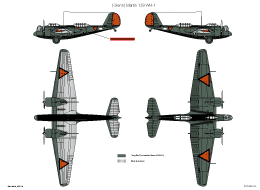
Martin 139 WH-2
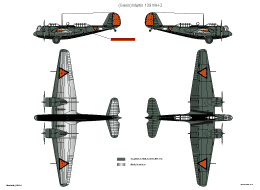
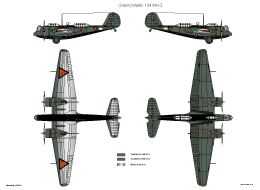
As a source for this scheme I used the scheme published by Peter C. Boer on "Mars et historia" .
Martin 166 WH-3 and WH-3A
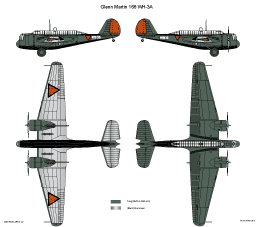
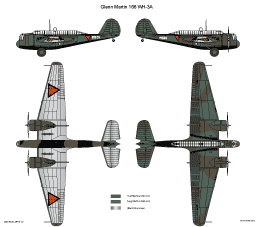
Literature.
| Militaire Luchtvaart in Nederlandsch-Indië in beeld. Deel 1 | Hugo Hooftman | Pag. 108 - 114 | 1978 | Uitgever: Europese Bibliotheek, Zaltbommel |
| Militaire Luchtvaart in Nederlandsch-Indië in beeld. Deel 1 | Hugo Hooftman | Pag. 115 - 132 | 1978 | Uitgever: Europese Bibliotheek, Zaltbommel |
| Air Enthusiast 22: Batavia's big sticks, the story of the Martin 139 bombers | Gerard Casius | Pag. 1 - 20 | 1983 | Uitgever: Pilot Press Ltd., Bromley, Kent |
| AVIA: 42e jaargang nummer 10: Luchtvloot van Plastic: De ML-KNIL Martin bombswerper | Hans Loeber | Pag. 345 - 347 | 1983 | Uitgevers Wyt, Rotterdam |
| Air Enthusiast 22: Batavia's big sticks, the story of the Martin 139 bombers | Gerard Casius | Pag. 1 - 20 | 1983 | Uitgever: Pilot Press Ltd., Bromley, Kent |
| 40 Jaar luchtvaart in Indië | Gerard Casius & Thijs Postma | Pag. 4; 50; 52; 66 - 67 | 1986 | Uitgeverij De Alk, Alkmaar |
| De Luchtstrijd rond Borneo | P.C.Boer | 1987 | Uitg. Van Holkema & Warendorf | |
| De Luchtstrijd om Indië | P.C.Boer e.a. | 1990 | Uitg. Van Holkema & Warendorf | |
| Squadrons van de Koninklijke Luchtmacht (derde herzien druk) | Willem Helfferich | Pag. 18 - | 1994 | Uitgevers Wyt, Rotterdam |
Websites.
Special thanks to mr M.T.A. Schep en M. Schonfeld for their information regarding the differences of the various types.

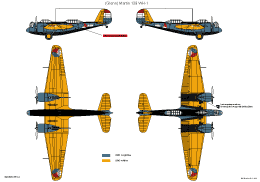
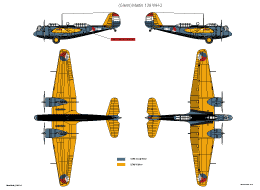
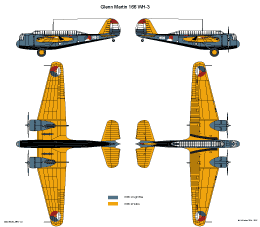
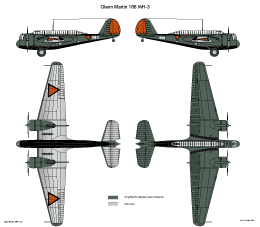
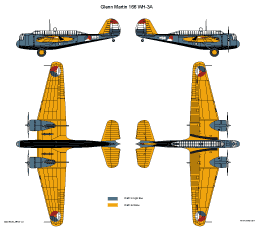
 Nederlands (nl-NL)
Nederlands (nl-NL)  English (United Kingdom)
English (United Kingdom)